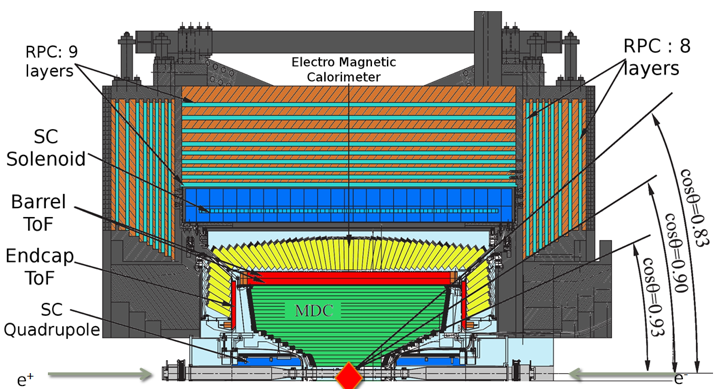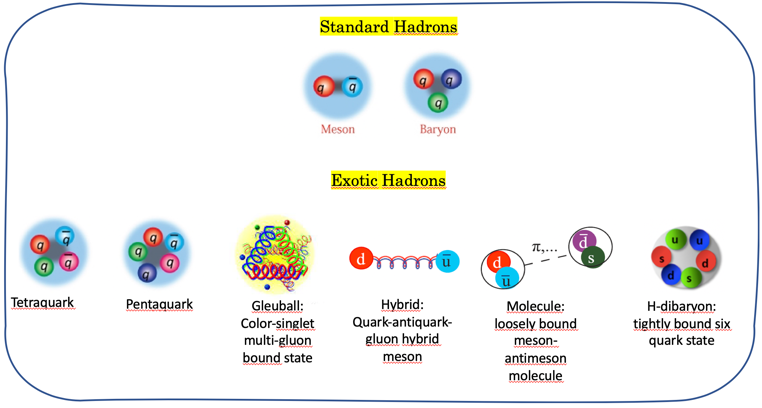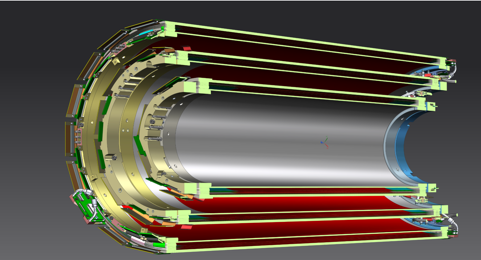The BESIII Experiment
The BESIII Experiment
Group composition:
Dr. Gianluigi Cibinetto
Dr. Isabella Garzia
Dr. Ilaria Balossino
Dr. Giulio Mezzadri
Dr. Riccardo Farinelli
PhD Marco Scodeggio
BESIII at the BEPCII accelerator is a major upgrade of BESII at the BEPC for the studies of hadron physics and τ-charm physics with the highest accuracy achieved until now.
The BESIII detector (Beijing Electron Spectrometer III) is a detector spectrometer successfully operating since 2008. Its rich physics program is focused to understand strong, electromagnetic and weak interactions.
The cylindrical core of the BESIII detector consists of a helium-based multilayer drift chamber (MDC), a plastic scintillator time-of-flight system (TOF), and a CsI(Tl) electromagnetic calorimeter (EMC), which are all enclosed in a superconducting solenoidal magnet providing a magnetic field of about 1T.
The solenoid is supported by an octagonal flux-return yoke with resistive plate counter muon identifier modules interleaved with steel.
The acceptance of charged particles and photons is 93% over the full solid angle.

On February 2019, BESIII finished accumulating 10 billions of Jpsi data, which is the world’s largest data sample produced directly from electron-positron annihilation. The Jpsi particle is a charmonium state discovered in 1974 at SLAC and Brookhaven National Laboratory.
It is composed of a charm and anticharm quark. Its high production rate in electron-positron annihilation together with the very large radiative decay rate makes it a perfect laboratory for studying exotic hadrons, glueballs (pure gluons states), hybrid states (quarks and glueballs), and multiquark states.
Thank to recent accelerator upgrades, new data sets were collected up to 4.7 GeV in the center-of-mass energy, with the possibility to reach 4.9 GeV in the next years.

The BESIII Collaboration has about 500 members from 72 institutions in the world, 15 of which are in Europe. The Department of Physics and Earth Sciences of University of Ferrara together with the Ferrara Section of INFN (Istituto Nazionale di Fisica Nucleare) have joined the Collaboration since 2013, and from the beginning play a fundamental role in the BESIII Collaboration. The BESIII-Ferrara group is involved in several activities, including data analyses, detector construction, and software development.
Data analysis (done and/or ongoing):
- Search for pentaquark states
- Relative phase between strong and electromagnetic amplitudes in J/𝜓 and 𝜓(2S) decays
- Search for glueball states in hadronic J/𝜓 decays
- Charmonium studies
- QCD related analyses
Hardware: the CGEM-IT project (Dr. Gianluigi Cibinetto as responsible of the project) ******* RISE2020 e tutte le sigle possibili:
In the last years, the inner part of the MDC detector has shown large aging effects. Since the data taking was extended for another 10 years, this made necessary to substitute the inner MDC with a more robust radiation hardness detector in order to achieve the same physics performances (or improve them).
In 2014, the Italian members of BESIII Collaboration (Ferrara, Torino and LNF) proposed a detector upgrade based on Cylindrical Gas Electron Multipliers (CGEM), which will replace the inner MDC detector. Based on the experience in building KLOE-II CGEM, the detector was designed and build in Italy, as well as the design and the construction of the ASIC needed for its readout.
The construction of this highly innovative and challenging detector has been supported by the European Commission that, within the framework of the H2020/RISE 2014 call, supports through the project BESIIICGEM an International Consortium devoted to its construction, a Consortium constituted by Institutions from Italy, Germany, Sweden and China, leads by INFN.
The research leading to these results has been performed within the FEST Project, funded by the European Commission in the call RISE-MSCA-H2020-2020.
Software activities:
- Detector simulation and digitization (ref.)
- Development of tracking algorithm with Hough transform method
- Development of quality assurance code for data collection
- Coordination of the CGEM-IT software working group
RD_FCC and other projects
- CREMLIN+
The group is involved in the development of an innovative inner Tracker based on the uRwell technology for the future detector for the Super Tau-Charm Factory in Novosibirsk (https://www.sciencedirect.com/science/article/pii/S2405601415001091). The group is involved in the design and the simulation of the detector. This detector will be the first of its kind. In particular, the group is developing a small prototype to test the capabilities of this technology.
- uRANIA-V
The shortage of He3 made it necessary to find an alternative solution for neutron detection. The group is working on the development of a technology to be applied to portals for homeland security and for radioactive waste materials management based on uRwell technology. The neutrons impinge on the cathode, that previously had been coated with a boron thin layer. The neutron interacts with the boron and converts in Lithium nuclei and alpha particles, that being charged, can ionize the gas and create signals. The group is responsible for the development of innovative electronics to count the neutrons by measuring the signals directly on the amplification stage. In addition, the group collaborates with the design development and participates in the test activities at the neutron source facility in ENEA.
- Future colliders
The high-energy physics community is planning to build big circular colliders to further investigate the Higgs boson and to search for New Physics. The next accelerator complex will be based on a 100 km-long e^+ e^- circular collider. The development of detectors has already started. The group is working within the IDEA collaboration to realize Muon Detectors. The chosen technology is the uRwell one, which will allow building large area detectors with unprecedented resolution. This feature is crucial in the search of the so-called long-lived particles, which are one of the proposed models to extend the Standard Model and justify the Dark Matter. The group is working on the software development and on the test of the prototypes by means of cosmic rays and test beams. Since recently, the group is also involved in the study of some benchmark channels to optimize the detector requirements before the preparation of the technical design report, foreseen in 2025. (https://home.cern/science/accelerators/future-circular-collider)
- AIDAInnova
In April 2021, the AIDAinnova project started. This four-year program is funded by the European Commission to push the development of the strategic program for future colliders. This program involves several European universities, research institutes, and laboratories. The group is involved in three main activities: the development of tracking for future detectors, also by means of neural network algorithms; the development of innovative electronics for micro-pattern gaseous detectors with pixellated readout; the development of innovative resistive micro-pattern gas detector. The first task is also coordinated by the group.


